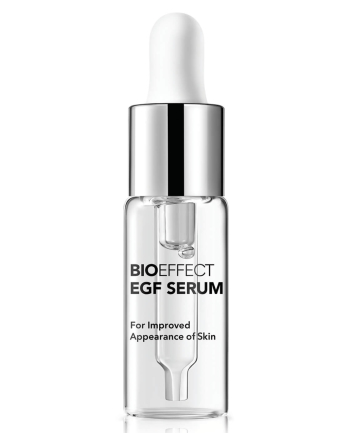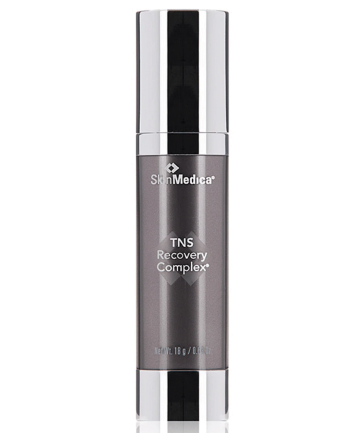Epidermal growth factor (EGF) sounds like some sort of scary sci-fi thing, and it sort of is — minus the "scary" part. It's actually been quite popular for a while — though you might be more familiar with the term, thanks to the viral facial nicknamed the "penis facial." (More on that later.)
The much-talked-about facial got people buzzing, but failed to highlight what a great anti-aging ingredient epidermal growth factors are... or the stellar products they're in.
Image via Imaxtree
The much-talked-about facial got people buzzing, but failed to highlight what a great anti-aging ingredient epidermal growth factors are... or the stellar products they're in.
Image via Imaxtree
Let's talk science: Growth factors are signaling molecules, usually large proteins. Cosmetic dermatologist, chief medical officer and founder of PFRANKMD, Dr. Paul Jarrod Frank, says that there are innumerous types throughout the body and many found naturally in skin.
Dermatologist Dr. Hadley King further explains that EGFs communicate messages relevant to growth and healing to the cells in skin. "When these signaling proteins bind to receptors on cell surfaces, they can send instructions to replicate, repair and rejuvenate," says King. "These messages can stimulate keratinocytes, melanocytes and fibroblasts, which produce collagen and elastin to thicken and tighten the skin."
Here's the thing, though: As we age, our skin produces smaller quantities of these growth factors... which is exactly where EGF skin care products come in.
Image via Imaxtree
Dermatologist Dr. Hadley King further explains that EGFs communicate messages relevant to growth and healing to the cells in skin. "When these signaling proteins bind to receptors on cell surfaces, they can send instructions to replicate, repair and rejuvenate," says King. "These messages can stimulate keratinocytes, melanocytes and fibroblasts, which produce collagen and elastin to thicken and tighten the skin."
Here's the thing, though: As we age, our skin produces smaller quantities of these growth factors... which is exactly where EGF skin care products come in.
Image via Imaxtree
Wondering how these incredible growth-stimulating proteins are transferred to a moisturizer or serum? Frank says that there are skin-derived options from a human source or bioengineered EGF products, sometimes from trick plant cells. Celebrity facialist and founder of Joanna Vargas Salons and Skin Care, Joanna Vargas, says that the peptides or protein chains are developed specifically to speed up wound healing at a cellular level.
"We have EGF in our skin to help repair and replicate existing cells," says Vargas. "EGF in skin care is meant to stimulate the same type of function in order to rejuvenate the skin and increase collagen production."
Growth factors are often found in serums and masks, but they are also in face and eye creams.
Buy now
"We have EGF in our skin to help repair and replicate existing cells," says Vargas. "EGF in skin care is meant to stimulate the same type of function in order to rejuvenate the skin and increase collagen production."
Growth factors are often found in serums and masks, but they are also in face and eye creams.
Buy now
King says that plant versions are bioengineered in a lab and can be barely-grown EGFs, such as those found in Bioeffect and DNAEGF Renewal. Vargas sources EGF from fruits and vegetables for her product line.
Buy now
Buy now
Hadley says that the human stem cells can come from any source. And we mean any source. In fact, this is where the "penis facial" got its nickname: Georgia Louise's Hollywood EGF facial reportedly uses EGF derived from cells from the removed foreskin of newborn Korean babies (yes, really).
SkinMedica also uses epidermal growth factors in its products. They're derived from several different human cells grown in a laboratory, including skin cells, bone marrow stem cells and fat stem cells. The growth factors can even be extracted from a person's blood, or platelet rich plasma (PRP).
King says that the SkinMedica TNS Recovery Complex, $179, specifically contains proteins derived from the fibroblasts of neonatal foreskin.
Buy now
SkinMedica also uses epidermal growth factors in its products. They're derived from several different human cells grown in a laboratory, including skin cells, bone marrow stem cells and fat stem cells. The growth factors can even be extracted from a person's blood, or platelet rich plasma (PRP).
King says that the SkinMedica TNS Recovery Complex, $179, specifically contains proteins derived from the fibroblasts of neonatal foreskin.
Buy now









